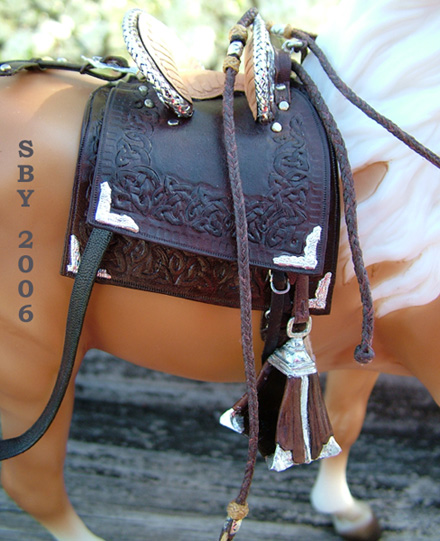 Here is a good close look at the off side of Timaru Star II #P5. It's a sign of the intricacy of the piece when my Home page can't hold all the pictures! This piece is proudly owned by R. Amador of CA, who had the patience to wait.
Here is a good close look at the off side of Timaru Star II #P5. It's a sign of the intricacy of the piece when my Home page can't hold all the pictures! This piece is proudly owned by R. Amador of CA, who had the patience to wait.
|
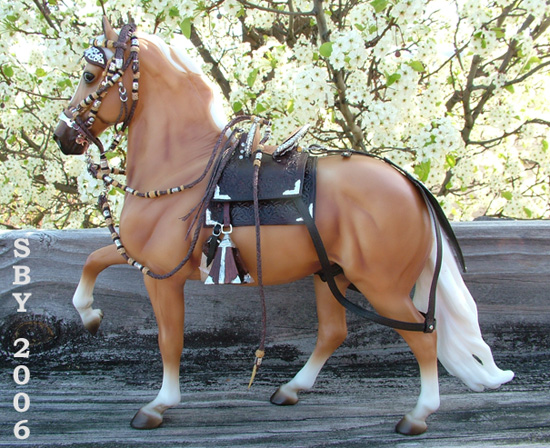 Yet another side view of the whole thing. Use this to compare with TSII #P4, below, and see how the color differences can be carried out. The basic rule of light horse + dark saddle does not necessarily have to be followed; nor does the equally basic rule of dark saddle + dark bridle. Yet there must be a balanced contrast between the parts; you should have contrast between saddle and seat. Peruvians cannot have big silver corner plates; they can only have 'big silver' in four places: basically the eyes, tail, cantle and pommel. If a set has this, then it must have silver braiding or binding on the cantle and pommel. If it has that much silver, it better be dark or at least a rich red-brown, so that there is contrast: the ultimate rule. If it has other-than-silver on the cantle and pommel binding, there is more chance for braidwork ornamentation, because this would match. One of the difficult decisions I faced was realizing that the most realistic and authentic approach -- dark brown plus dark brown braidwork everywhere, without much silver -- would look very plain and unspectacular, that is, without contrast. In modeldom there is a very real chance that the chiefs outnumber the indians.
Yet another side view of the whole thing. Use this to compare with TSII #P4, below, and see how the color differences can be carried out. The basic rule of light horse + dark saddle does not necessarily have to be followed; nor does the equally basic rule of dark saddle + dark bridle. Yet there must be a balanced contrast between the parts; you should have contrast between saddle and seat. Peruvians cannot have big silver corner plates; they can only have 'big silver' in four places: basically the eyes, tail, cantle and pommel. If a set has this, then it must have silver braiding or binding on the cantle and pommel. If it has that much silver, it better be dark or at least a rich red-brown, so that there is contrast: the ultimate rule. If it has other-than-silver on the cantle and pommel binding, there is more chance for braidwork ornamentation, because this would match. One of the difficult decisions I faced was realizing that the most realistic and authentic approach -- dark brown plus dark brown braidwork everywhere, without much silver -- would look very plain and unspectacular, that is, without contrast. In modeldom there is a very real chance that the chiefs outnumber the indians.
|
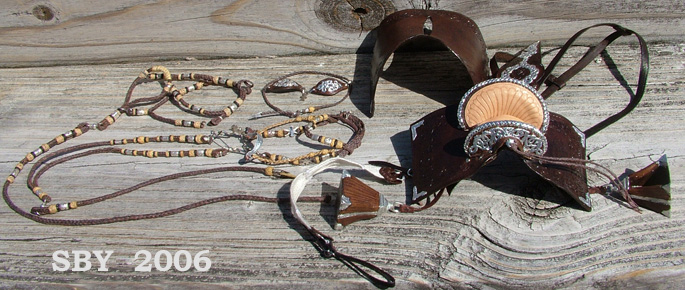 #P5. This particular way of shooting an entire set reveals how important it is to shape certain parts, such as the corona or "saddle blanket." The corona is not really a saddle blanket, but the lower level of the visible ensemble, much like the skirt on a mochila saddle of the Old West. In the real-life Peruvian, there is indeed a woolen blanket, to absorb sweat and protect the horse. But Breyers do not sweat and model tackmakers desperately need that empty layer of space ---I have omitted the woolen blanket.
#P5. This particular way of shooting an entire set reveals how important it is to shape certain parts, such as the corona or "saddle blanket." The corona is not really a saddle blanket, but the lower level of the visible ensemble, much like the skirt on a mochila saddle of the Old West. In the real-life Peruvian, there is indeed a woolen blanket, to absorb sweat and protect the horse. But Breyers do not sweat and model tackmakers desperately need that empty layer of space ---I have omitted the woolen blanket.
|
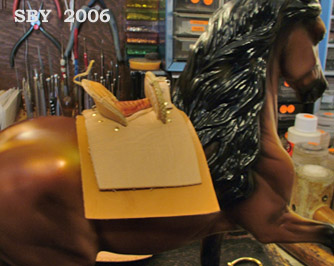 TSII #P4 took so long partly because I made two of them. It was clear to me I'd be working with Breyer's InOlvidable, Linda York's Peruvian Paso, for a long time to come. Despite having made three previous Peruvian Paso sets, I wanted to improve, perfect and standardize my techniques for the one mold. I did something I've never done before: I created a mockup, a test saddle, purely for engineering purposes. The trick worked. I call it #P3.5. Naturally I've always wanted a Peruvian saddle for myself; but to make this one show-worthy I shall have to practically tear it apart again and tool it. Perhaps that is my fate. I could write books on how tackmakers should, mentally at least, always be ready to destroy their own work...
TSII #P4 took so long partly because I made two of them. It was clear to me I'd be working with Breyer's InOlvidable, Linda York's Peruvian Paso, for a long time to come. Despite having made three previous Peruvian Paso sets, I wanted to improve, perfect and standardize my techniques for the one mold. I did something I've never done before: I created a mockup, a test saddle, purely for engineering purposes. The trick worked. I call it #P3.5. Naturally I've always wanted a Peruvian saddle for myself; but to make this one show-worthy I shall have to practically tear it apart again and tool it. Perhaps that is my fate. I could write books on how tackmakers should, mentally at least, always be ready to destroy their own work...
|
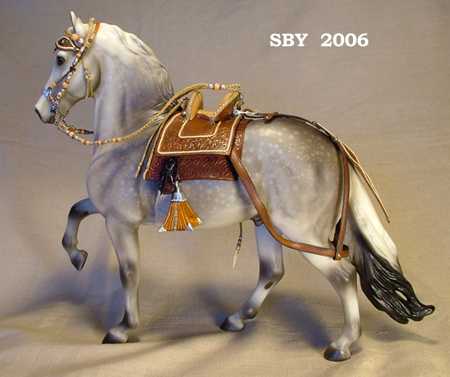 This is Timaru Star II #P4, shown on my horse Fazioli. This set was begun in December of 2005 (the design work started in November) and finished in January. It was the first Peruvian I'd made with braided-rawhide binding on the cantle and pommel, and shows what is possible with a color combination approach of "rust-red-and-rawhide" tones, plus braidwork (the braided applique (white lines) on skirt and tapacola). Like the silver Parade sets, the amount and location of silver and decoration on a Peruvian is fixed by the shape and style of the saddles themselves; but within these constraints there is still a great deal of individual variation possible.
This is Timaru Star II #P4, shown on my horse Fazioli. This set was begun in December of 2005 (the design work started in November) and finished in January. It was the first Peruvian I'd made with braided-rawhide binding on the cantle and pommel, and shows what is possible with a color combination approach of "rust-red-and-rawhide" tones, plus braidwork (the braided applique (white lines) on skirt and tapacola). Like the silver Parade sets, the amount and location of silver and decoration on a Peruvian is fixed by the shape and style of the saddles themselves; but within these constraints there is still a great deal of individual variation possible.
|
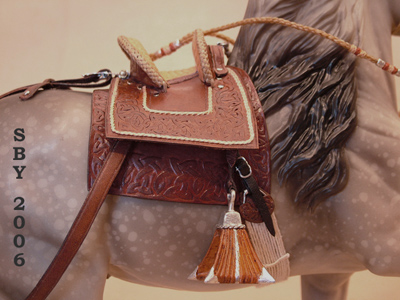 This offside shot of the P4 shows the tooling and braidwork. It also shows how it is sometimes necessary to distort and warp the very shape of a saddle in order to get it to fit a certain model's back. In order not to extend over the hips, the saddle was shrunk fore-and-aft; and it was lengthened towards the belly in order to look correct from the side on this model. If you view full-scale Peruvian saddles you will see this is so; real saddles are almost twice as long as this one and shallower. You might also conclude that the Yorkie has a savagely compressed back and neck, and no withers whatsoever. Model tackmakers are often saddled with such difficulties; the "art" is make the horse look absolutely as good as possible. I give thanks that dolls' hips are so narrow. :)
This offside shot of the P4 shows the tooling and braidwork. It also shows how it is sometimes necessary to distort and warp the very shape of a saddle in order to get it to fit a certain model's back. In order not to extend over the hips, the saddle was shrunk fore-and-aft; and it was lengthened towards the belly in order to look correct from the side on this model. If you view full-scale Peruvian saddles you will see this is so; real saddles are almost twice as long as this one and shallower. You might also conclude that the Yorkie has a savagely compressed back and neck, and no withers whatsoever. Model tackmakers are often saddled with such difficulties; the "art" is make the horse look absolutely as good as possible. I give thanks that dolls' hips are so narrow. :)
|
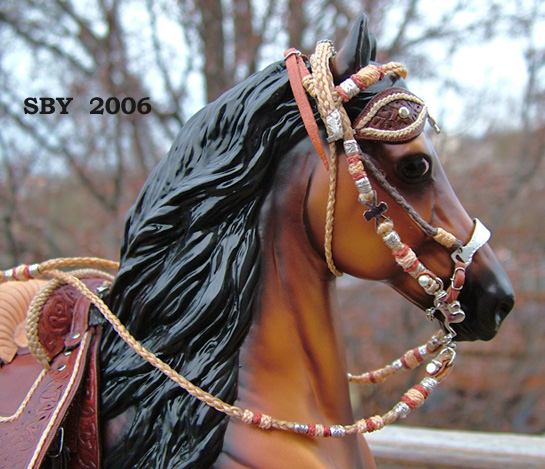 This was taken outdoors on a cloudy winter day. I have found no substitute for outdoor light. Of course the Jaquima or halter is missing, having been sent to the customer months before. This view of #P4 is evidence of how difficult it is to 'keep around' the many parts of a Peruvian Paso saddle set. The creation of #P4 was spread out from June of 2005 to January of 2006, a total of eight months. Model tackmaking is a series of accumulations of intensities, a juggling of time and attention and skill. To quote Caroline Hamilton, "State of the art [models]... cost a great deal of money, even if there is no such thing as a rich dolls' house builder."
This was taken outdoors on a cloudy winter day. I have found no substitute for outdoor light. Of course the Jaquima or halter is missing, having been sent to the customer months before. This view of #P4 is evidence of how difficult it is to 'keep around' the many parts of a Peruvian Paso saddle set. The creation of #P4 was spread out from June of 2005 to January of 2006, a total of eight months. Model tackmaking is a series of accumulations of intensities, a juggling of time and attention and skill. To quote Caroline Hamilton, "State of the art [models]... cost a great deal of money, even if there is no such thing as a rich dolls' house builder."
|
 Here is a good close look at the off side of Timaru Star II #P5. It's a sign of the intricacy of the piece when my Home page can't hold all the pictures! This piece is proudly owned by R. Amador of CA, who had the patience to wait.
Here is a good close look at the off side of Timaru Star II #P5. It's a sign of the intricacy of the piece when my Home page can't hold all the pictures! This piece is proudly owned by R. Amador of CA, who had the patience to wait.
 Yet another side view of the whole thing. Use this to compare with TSII #P4, below, and see how the color differences can be carried out. The basic rule of light horse + dark saddle does not necessarily have to be followed; nor does the equally basic rule of dark saddle + dark bridle. Yet there must be a balanced contrast between the parts; you should have contrast between saddle and seat. Peruvians cannot have big silver corner plates; they can only have 'big silver' in four places: basically the eyes, tail, cantle and pommel. If a set has this, then it must have silver braiding or binding on the cantle and pommel. If it has that much silver, it better be dark or at least a rich red-brown, so that there is contrast: the ultimate rule. If it has other-than-silver on the cantle and pommel binding, there is more chance for braidwork ornamentation, because this would match. One of the difficult decisions I faced was realizing that the most realistic and authentic approach -- dark brown plus dark brown braidwork everywhere, without much silver -- would look very plain and unspectacular, that is, without contrast. In modeldom there is a very real chance that the chiefs outnumber the indians.
Yet another side view of the whole thing. Use this to compare with TSII #P4, below, and see how the color differences can be carried out. The basic rule of light horse + dark saddle does not necessarily have to be followed; nor does the equally basic rule of dark saddle + dark bridle. Yet there must be a balanced contrast between the parts; you should have contrast between saddle and seat. Peruvians cannot have big silver corner plates; they can only have 'big silver' in four places: basically the eyes, tail, cantle and pommel. If a set has this, then it must have silver braiding or binding on the cantle and pommel. If it has that much silver, it better be dark or at least a rich red-brown, so that there is contrast: the ultimate rule. If it has other-than-silver on the cantle and pommel binding, there is more chance for braidwork ornamentation, because this would match. One of the difficult decisions I faced was realizing that the most realistic and authentic approach -- dark brown plus dark brown braidwork everywhere, without much silver -- would look very plain and unspectacular, that is, without contrast. In modeldom there is a very real chance that the chiefs outnumber the indians.
 #P5. This particular way of shooting an entire set reveals how important it is to shape certain parts, such as the corona or "saddle blanket." The corona is not really a saddle blanket, but the lower level of the visible ensemble, much like the skirt on a mochila saddle of the Old West. In the real-life Peruvian, there is indeed a woolen blanket, to absorb sweat and protect the horse. But Breyers do not sweat and model tackmakers desperately need that empty layer of space ---I have omitted the woolen blanket.
#P5. This particular way of shooting an entire set reveals how important it is to shape certain parts, such as the corona or "saddle blanket." The corona is not really a saddle blanket, but the lower level of the visible ensemble, much like the skirt on a mochila saddle of the Old West. In the real-life Peruvian, there is indeed a woolen blanket, to absorb sweat and protect the horse. But Breyers do not sweat and model tackmakers desperately need that empty layer of space ---I have omitted the woolen blanket.
 TSII #P4 took so long partly because I made two of them. It was clear to me I'd be working with Breyer's InOlvidable, Linda York's Peruvian Paso, for a long time to come. Despite having made three previous Peruvian Paso sets, I wanted to improve, perfect and standardize my techniques for the one mold. I did something I've never done before: I created a mockup, a test saddle, purely for engineering purposes. The trick worked. I call it #P3.5. Naturally I've always wanted a Peruvian saddle for myself; but to make this one show-worthy I shall have to practically tear it apart again and tool it. Perhaps that is my fate. I could write books on how tackmakers should, mentally at least, always be ready to destroy their own work...
TSII #P4 took so long partly because I made two of them. It was clear to me I'd be working with Breyer's InOlvidable, Linda York's Peruvian Paso, for a long time to come. Despite having made three previous Peruvian Paso sets, I wanted to improve, perfect and standardize my techniques for the one mold. I did something I've never done before: I created a mockup, a test saddle, purely for engineering purposes. The trick worked. I call it #P3.5. Naturally I've always wanted a Peruvian saddle for myself; but to make this one show-worthy I shall have to practically tear it apart again and tool it. Perhaps that is my fate. I could write books on how tackmakers should, mentally at least, always be ready to destroy their own work...
 This is Timaru Star II #P4, shown on my horse Fazioli. This set was begun in December of 2005 (the design work started in November) and finished in January. It was the first Peruvian I'd made with braided-rawhide binding on the cantle and pommel, and shows what is possible with a color combination approach of "rust-red-and-rawhide" tones, plus braidwork (the braided applique (white lines) on skirt and tapacola). Like the silver Parade sets, the amount and location of silver and decoration on a Peruvian is fixed by the shape and style of the saddles themselves; but within these constraints there is still a great deal of individual variation possible.
This is Timaru Star II #P4, shown on my horse Fazioli. This set was begun in December of 2005 (the design work started in November) and finished in January. It was the first Peruvian I'd made with braided-rawhide binding on the cantle and pommel, and shows what is possible with a color combination approach of "rust-red-and-rawhide" tones, plus braidwork (the braided applique (white lines) on skirt and tapacola). Like the silver Parade sets, the amount and location of silver and decoration on a Peruvian is fixed by the shape and style of the saddles themselves; but within these constraints there is still a great deal of individual variation possible.
 This offside shot of the P4 shows the tooling and braidwork. It also shows how it is sometimes necessary to distort and warp the very shape of a saddle in order to get it to fit a certain model's back. In order not to extend over the hips, the saddle was shrunk fore-and-aft; and it was lengthened towards the belly in order to look correct from the side on this model. If you view full-scale Peruvian saddles you will see this is so; real saddles are almost twice as long as this one and shallower. You might also conclude that the Yorkie has a savagely compressed back and neck, and no withers whatsoever. Model tackmakers are often saddled with such difficulties; the "art" is make the horse look absolutely as good as possible. I give thanks that dolls' hips are so narrow. :)
This offside shot of the P4 shows the tooling and braidwork. It also shows how it is sometimes necessary to distort and warp the very shape of a saddle in order to get it to fit a certain model's back. In order not to extend over the hips, the saddle was shrunk fore-and-aft; and it was lengthened towards the belly in order to look correct from the side on this model. If you view full-scale Peruvian saddles you will see this is so; real saddles are almost twice as long as this one and shallower. You might also conclude that the Yorkie has a savagely compressed back and neck, and no withers whatsoever. Model tackmakers are often saddled with such difficulties; the "art" is make the horse look absolutely as good as possible. I give thanks that dolls' hips are so narrow. :)
 This was taken outdoors on a cloudy winter day. I have found no substitute for outdoor light. Of course the Jaquima or halter is missing, having been sent to the customer months before. This view of #P4 is evidence of how difficult it is to 'keep around' the many parts of a Peruvian Paso saddle set. The creation of #P4 was spread out from June of 2005 to January of 2006, a total of eight months. Model tackmaking is a series of accumulations of intensities, a juggling of time and attention and skill. To quote Caroline Hamilton, "State of the art [models]... cost a great deal of money, even if there is no such thing as a rich dolls' house builder."
This was taken outdoors on a cloudy winter day. I have found no substitute for outdoor light. Of course the Jaquima or halter is missing, having been sent to the customer months before. This view of #P4 is evidence of how difficult it is to 'keep around' the many parts of a Peruvian Paso saddle set. The creation of #P4 was spread out from June of 2005 to January of 2006, a total of eight months. Model tackmaking is a series of accumulations of intensities, a juggling of time and attention and skill. To quote Caroline Hamilton, "State of the art [models]... cost a great deal of money, even if there is no such thing as a rich dolls' house builder."
 which can be thought of as P3.5. The page is really a rehash of our Home Page as it appeared in May and early June of 2006.
which can be thought of as P3.5. The page is really a rehash of our Home Page as it appeared in May and early June of 2006.
 You can compare Timaru Star II #P5 with the previous four by seeing #P1, P2 & P3 on the Peruvian page and #P4 on Sneak Peeks. From the start I knew I wanted #P5 to be a very dark brown with an abundance of silver, yet still use the Celtic tooling pattern which I so fell in love with. TSII #P4 was started in December, and ran into January; and on its heels, flush with what I thought was success and inspiration, I started #P5. Over one hundred grueling concentrated hours and a solid two months later, having repeated what I had just done twice before (remember P3.5, the mockup), I can truly say that the Peruvian Paso saddle set is the HARDEST piece I can make. To quote Clavell's Aristotle Quance, "Me price is up!!" As of the next Lottery, look for a serious increase. Those who hold winning slots from my 2005 Lottery shall, of course, enjoy last year's prices. :) Believe you me, these pieces are worth it: quality does not cost so much as it pays. You will not see detail like this anywhere else. This is our twenty-eighth year of professional tackmaking!! That kind of experience, skill and mastery is not to be had easily, quickly or cheaply. If nowhere else, the model horse hobby gives a forum for the appreciation of those arts and crafts that are still handmade, the old fashioned way... increasingly rare... increasingly valuable. Let me be the first to thank my long-suffering customers for their patience with this often slow artist... hopefully the results are worth it.
You can compare Timaru Star II #P5 with the previous four by seeing #P1, P2 & P3 on the Peruvian page and #P4 on Sneak Peeks. From the start I knew I wanted #P5 to be a very dark brown with an abundance of silver, yet still use the Celtic tooling pattern which I so fell in love with. TSII #P4 was started in December, and ran into January; and on its heels, flush with what I thought was success and inspiration, I started #P5. Over one hundred grueling concentrated hours and a solid two months later, having repeated what I had just done twice before (remember P3.5, the mockup), I can truly say that the Peruvian Paso saddle set is the HARDEST piece I can make. To quote Clavell's Aristotle Quance, "Me price is up!!" As of the next Lottery, look for a serious increase. Those who hold winning slots from my 2005 Lottery shall, of course, enjoy last year's prices. :) Believe you me, these pieces are worth it: quality does not cost so much as it pays. You will not see detail like this anywhere else. This is our twenty-eighth year of professional tackmaking!! That kind of experience, skill and mastery is not to be had easily, quickly or cheaply. If nowhere else, the model horse hobby gives a forum for the appreciation of those arts and crafts that are still handmade, the old fashioned way... increasingly rare... increasingly valuable. Let me be the first to thank my long-suffering customers for their patience with this often slow artist... hopefully the results are worth it.
 (certainly striking, and probably inauthentic) is the silver filigree on the Tapa Cola (tail cover) and the rear of the cantle. This "encrusted silver" look, which I am quite pleased with!, took waa-ayy-aayy too much time... yet that's always the way of great detail! This technology, first used on a Parade set, gives flashing and detailed silver at correct scale and, since it's Aluminum, it will never tarnish. Being held on with uncounted handcut prongs, all of which pierce the leather and are bent through behind, it will never drop off. You have to line the tapa cola, not so much to protect the horse as to protect the owner!... trusting to glue... but the method is flexible, so it allows the tapa cola to bend. It was only then I realized that REAL Tapa Colas laden with that much silver could not possibly bend! So forgive me for the fanaticism of a true silver-brain. Yes, it really is a Celtic design... another excess I can only put down to artist enthusiasm, for I very much doubt there is much connection between the two cultures.
(certainly striking, and probably inauthentic) is the silver filigree on the Tapa Cola (tail cover) and the rear of the cantle. This "encrusted silver" look, which I am quite pleased with!, took waa-ayy-aayy too much time... yet that's always the way of great detail! This technology, first used on a Parade set, gives flashing and detailed silver at correct scale and, since it's Aluminum, it will never tarnish. Being held on with uncounted handcut prongs, all of which pierce the leather and are bent through behind, it will never drop off. You have to line the tapa cola, not so much to protect the horse as to protect the owner!... trusting to glue... but the method is flexible, so it allows the tapa cola to bend. It was only then I realized that REAL Tapa Colas laden with that much silver could not possibly bend! So forgive me for the fanaticism of a true silver-brain. Yes, it really is a Celtic design... another excess I can only put down to artist enthusiasm, for I very much doubt there is much connection between the two cultures.
 For the pivot, or screw, I used a doll house bolt and nut, made of machined brass, purchased at the local hobby shop. Although it looks very elegant, it was a royal pain to install. I absolutely dread having to ever take it off! (Excuse the lifted cruceta or cross strap in the picture. Shaping covers a multitude of sins.) Another trouble with #P5 was I didn't know what color to make the seat pieces. In my complex method of construction, they come last. There is relief in not having to match them exactly to any tooling on the skirt, an advantage... but there is difficulty in thinning and tooling them properly: no mistakes allowed. As I said with #P4, they are tooled also from the back, which is called repousse [ray-poo-say]. In the case of this saddle I honestly didn't know what color they would be until the very last moment. Then they declared (having been natural all this time) that Natural would be just fine, thank you!! This whole set is another example of what can be done WITHOUT any red tones. It was made possible by the palomino horse. TSII #P5 would probably look great on the buckskin ("Causin A Commotion") but on a red Yorkie, such as "Cobrizo" or "Del Fuego," it might look pale and bleached.
For the pivot, or screw, I used a doll house bolt and nut, made of machined brass, purchased at the local hobby shop. Although it looks very elegant, it was a royal pain to install. I absolutely dread having to ever take it off! (Excuse the lifted cruceta or cross strap in the picture. Shaping covers a multitude of sins.) Another trouble with #P5 was I didn't know what color to make the seat pieces. In my complex method of construction, they come last. There is relief in not having to match them exactly to any tooling on the skirt, an advantage... but there is difficulty in thinning and tooling them properly: no mistakes allowed. As I said with #P4, they are tooled also from the back, which is called repousse [ray-poo-say]. In the case of this saddle I honestly didn't know what color they would be until the very last moment. Then they declared (having been natural all this time) that Natural would be just fine, thank you!! This whole set is another example of what can be done WITHOUT any red tones. It was made possible by the palomino horse. TSII #P5 would probably look great on the buckskin ("Causin A Commotion") but on a red Yorkie, such as "Cobrizo" or "Del Fuego," it might look pale and bleached.